#siddham
Explore tagged Tumblr posts
Photo
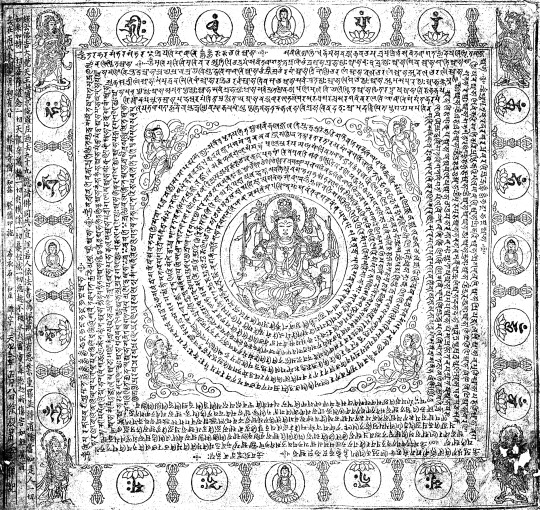
Pratisara Mantra, 927 CE, found near Luoyang, China
2K notes
·
View notes
Text

Without the imperatives of capitalism, would we have invented planned obsolescence?
#art#retrofuture#design#collage#aesthetic#gas mask#work#siddham#bonji#fudo#trench coat#half tone#monochrome
134 notes
·
View notes
Text
Ohmmmmmmmm.....

5 notes
·
View notes
Text
Laṃ - Vaṃ - Raṃ - Yaṃ - Haṃ - Oṃ - ṃ

40 notes
·
View notes
Text
Siddham
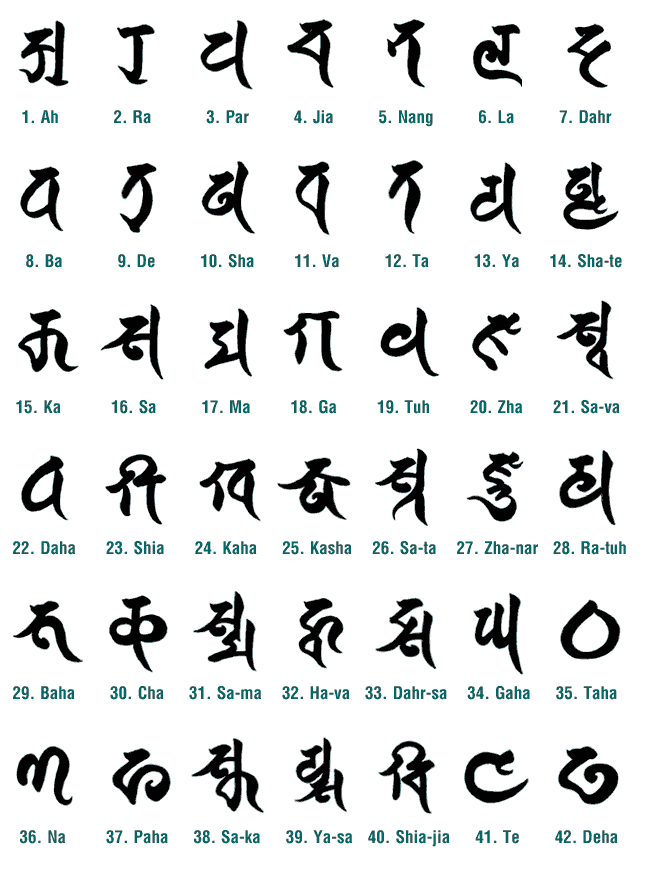
Siddham is a language used to write Sanskrit, primarily by Buddhist institutions. It was used prolifically during the 800-1200s and gave rise to the Tibetan alphabet. It’s known in Japan as Bonji, where it’s used primarily in esoteric mantra texts by the Shingon tradition, and in popular culture it’s often used to indicate some kind of magical or occult phenomena at work.
2 notes
·
View notes
Text
#bus#yatra#Politics#rayalseema#elections#campaign#PrajaGalam#Siddham#schedule#CMJagan#YSJaganMohanReddy#NaraChandrababuNaidu#ChandrababuNaidu#CBN#AndhraPradesh
0 notes
Text

Ys jagan speech in siddham
Jagan has been repeatedly injecting into the minds of the people that 80 percent of elected and nominated posts — from ward members to sarpanches, MPTC members to Mandal Presidents, ZPTC members to ZP chairmen, MLAs, MLCs, Assembly Speaker, Council Chairman, Cabinet Ministers and Deputy Chief Ministers — were filled with backward and downtrodden sections. “Those who have never got an opportunity to ascend to such positions have all been accommodated by our government. Even in the direct benefit transfer (DBT) schemes, the biggest chunk covered 80 percent of the people belonging to weaker sections.”
0 notes
Text
I made stickers from DMC1 DT gauge runes



Bonus, my variations






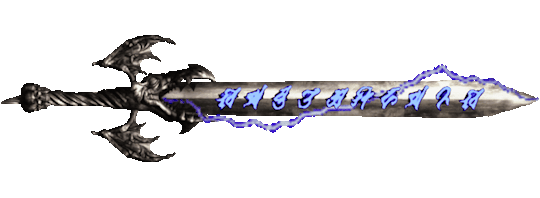
#devil may cry#dmc#original dmc#devil trigger#dt gauge#runes#siddham alphabet#bonji runes#alastor#alastor lightning#gif#my gif#my gif edit#animated gif#sticker#gif sticker
24 notes
·
View notes
Text

Discover Advanced Treatment at Siddham ENT Hospital
Siddham Hospital offers advanced treatment options to address all your ENT concerns. Discover advanced treatment at Siddham ENT Hospital in Jaipur, where expert care meets state-of-the-art technology. From diagnosis to recovery, we ensure personalized and effective solutions for your ear, nose, and throat issues. Trust Siddham Hospital for compassionate care and unparalleled medical expertise.
0 notes
Text
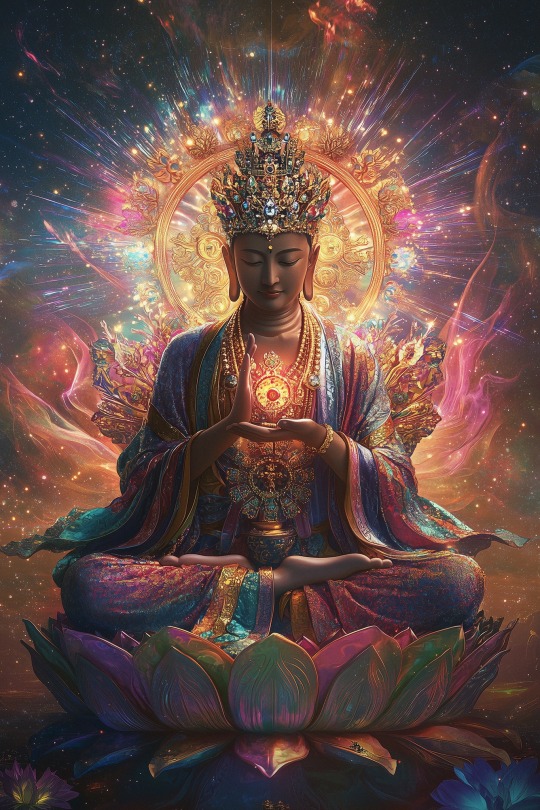
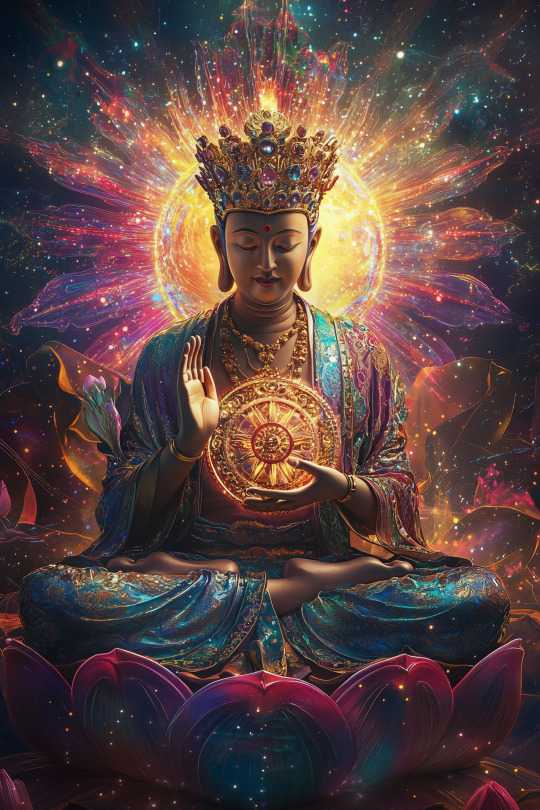
"Listen my love, illumination is eternal. Now is always evolving. As there are billions of stars, there are billions of steps. As there are billions of souls, there are billions of ways to grow." ~Rumi
Maha Vairocana - Great Illuminator Talon Abraxas Mahāvairochana (virocana) is the central figure in Tantric Buddhism, the lord of the Tathāgata family. He represents, in anthropomorphic form, the fundamental principle and the eternal existance of the universe. He is viewed as the embodiment of the 'Awareness of the Continuum of Reality', one of the five awarenesses. His body is said to consist of all forms in the universe, his voice to be all sounds, and his mind to consist of all thought. Mantra of light (Amogha Empowerment Light Mantra 不空大灌頂光真言) "Oṃ! Amogha vairocana, mahā-mudrā, maṇi-padma, jvala pravartaya hūṃ!" Om! invincible Vairocana, the Great (hand) Seal, the Gem (on the) Lotus, the Flame, (Please) come forth, hum!" (center- 'Ah' in Siddham Sanskrit)
34 notes
·
View notes
Text
Cursed Coins (A Disappointment)
@elvesdragonsanddarkmagic was kind enough to send me their meticulous recreations of the cursed coin model, so I had to dick around about 80% less with securing screenshots:

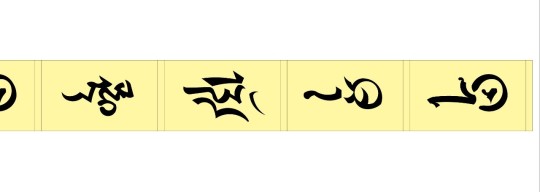
The same set of eight runes repeats on both halves of the coin face, and the same four runes repeat around the length of its edge:
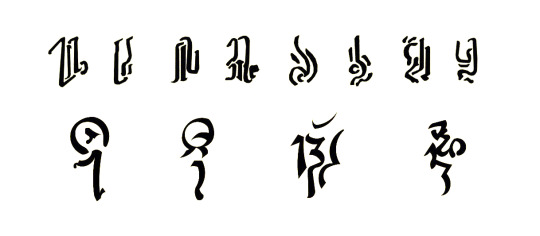
None of these then show up anywhere else. There are a couple in—of all things—Aditi's flashback spell that are just close enough in their general shape and concept that if someone later said, "yeah those are supposed to be the same" I would believe them, and then a couple more that if someone said "the coin face runes correspond to runes from Aditi's spell" I'd tentatively match up. BUT it's really a lot more likely that's just a coincidence:
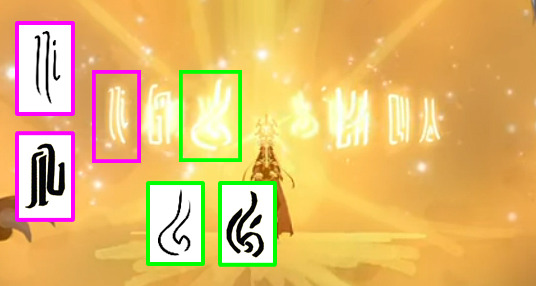
Anyway, since I had nothing better to do I wound up looking at like 30+ different real-world writing systems to see if there were any similarities, the way some of the magic mirror runes are clipped from Devanagari. This was kind of iffy from the start, since the face runes and edge runes honestly look like they come from different writing systems, but whatever. I'm not well-versed in any South/Southeast Asian, Oceanic, or particularly ancient written languages to recognize them on sight, so it wasn't totally wasted effort?
The most similar in "feel," particularly for the edge runes, would probably be something like Siddham, which is an ancestor of Devanagari but still used (pretty much exclusively) in writing Sanskrit texts for Buddhist practices:
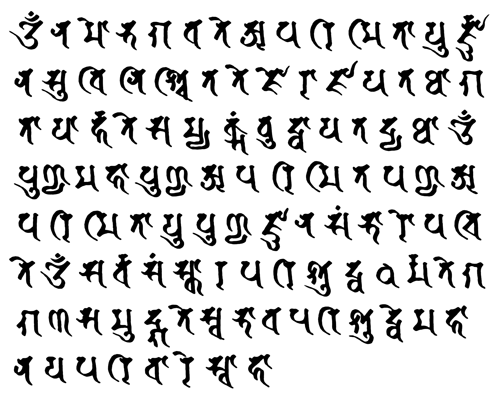
But it can't really be said to be any closer to that than to something like Terran writing from Final Fantasy IX or this one dude's super fancy Latin alphabet styling:
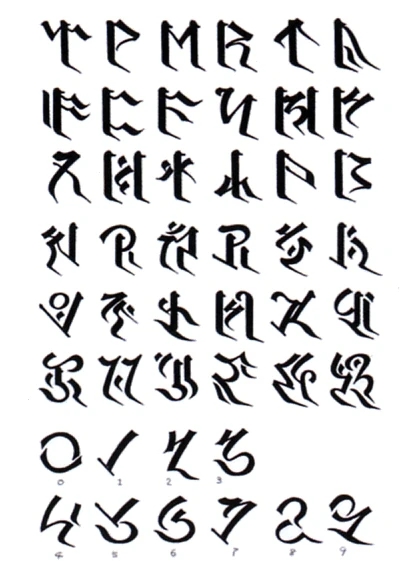
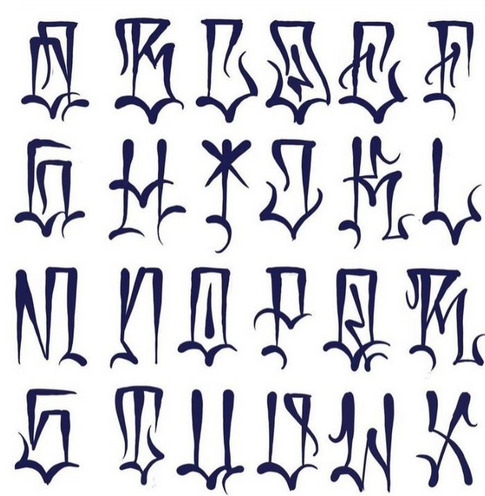
So yeah, at the moment it appears to be just random custom designs, but with some potential of other things matching it in the future.
THIS, though, I'm still 150% certain is going to be a THING:
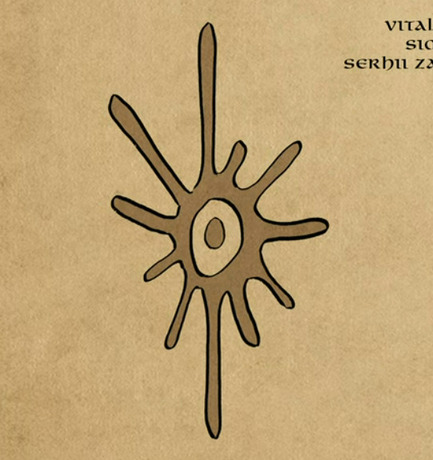
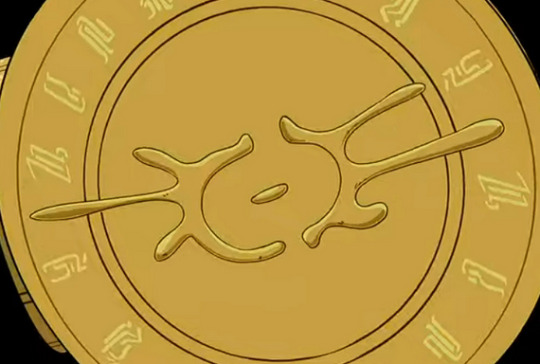
What thing exactly remains to be seen. What would be the significance of a star seemingly split in two? A fallen star broken on impact? Does it represent something else entirely, like a broken wax seal or a splash of liquid or a wide-open eye? IT'S A THING, THOUGH, DAMMIT.
#anyway this was useless but i learned unrelated things so#not a TOTAL waste of a weekend#cursed coin#dark magic#deep magic#meta#analysis#scene comparison
8 notes
·
View notes
Photo
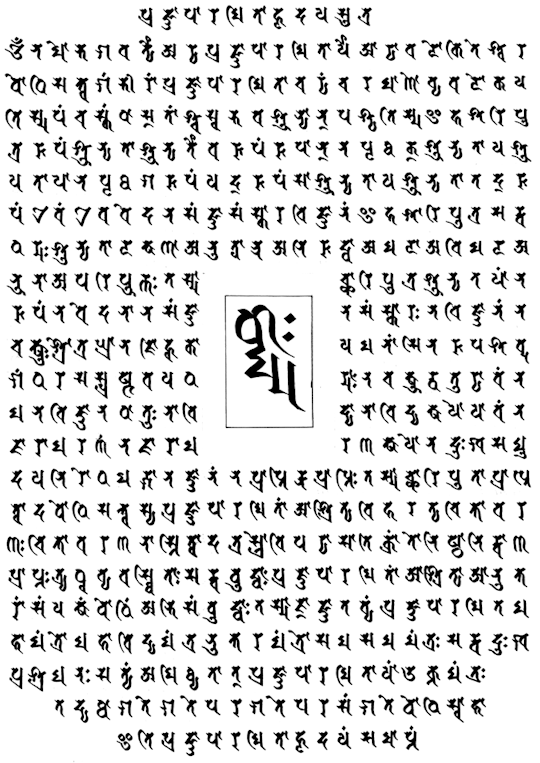
Heart Sutra in the Siddham script
25 notes
·
View notes
Text

āṃḥ
80 notes
·
View notes
Text
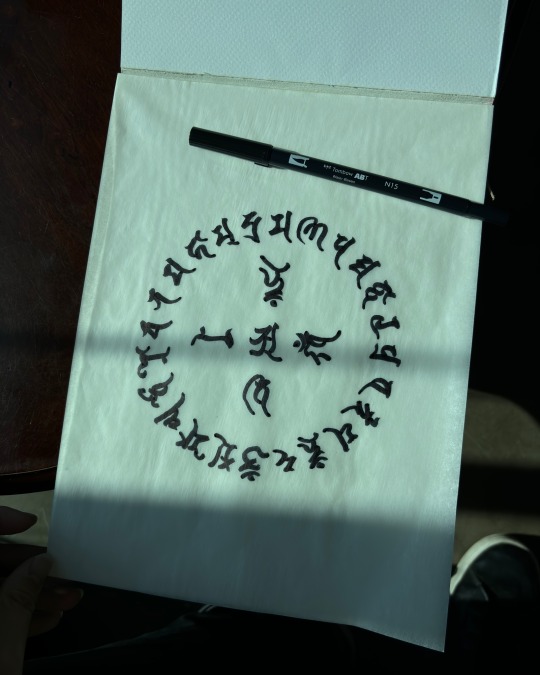
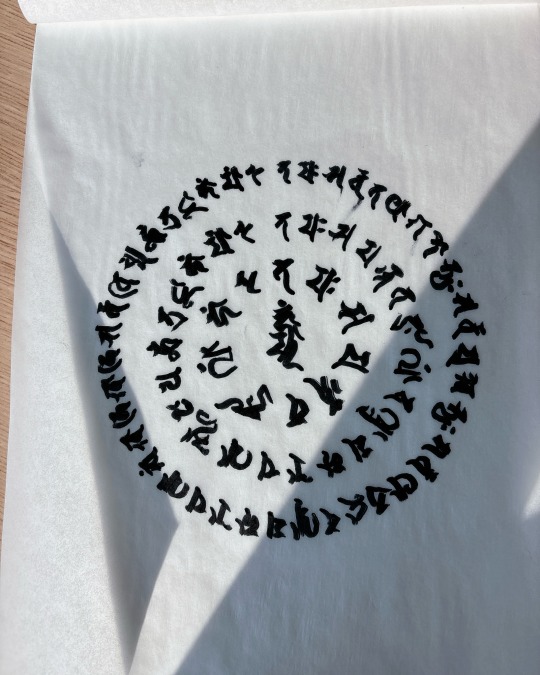
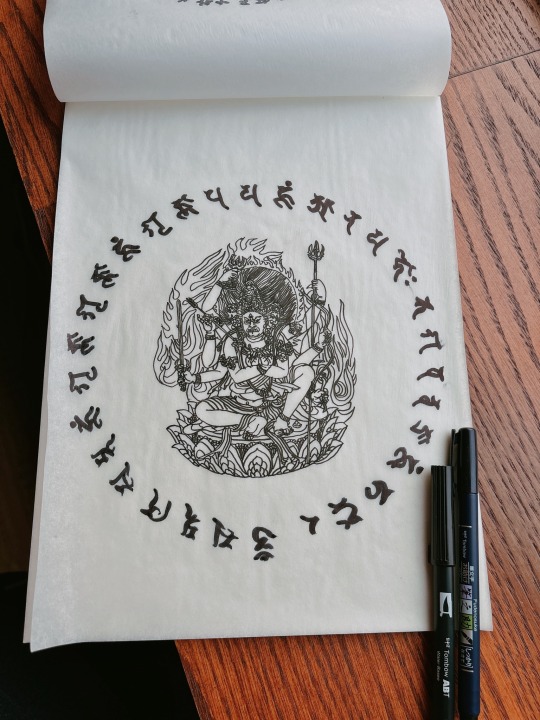

some siddham and also a couple attempts at drawing buddha images i did these past few days :3
4 notes
·
View notes
Text
Les Civilisations Paléomagos
La découverte pour les humains du monde magique suite à l’Événement de Stonehenge ne fut pas le seul choc majeur qui suivit l’Éveil de la Magie.
Les multiples barrières de dissimulations tombées révélèrent également les Mers, que même les magus avaient oubliés… mais surtout de multiples ruines à travers le monde, prédatant toutes les civilisations connues!
Ces ruines, il s’avéra vite, étaient les vestiges des civilisations Paléomagos, peuples d’Homo Magicus vivant durant le Mésolitique, et ayant disparu au Néolithique.
Ces civilisations faisaient toutes un grand usage de magie, à un niveau équivalent, voire parfois supérieur au niveau de connaissance et de maîtrise de la magie actuel, et même un niveau technique et culturel proche des Homo Sapiens durant l’Antiquité. De plus, l’usage de magie fait que ces civilisations pouvaient voyager et communiquer à travers le monde avec une facilité qui ne sera plus vue jusqu’à la Révolution Industrielle. Même si on avait perdu tout souvenir d’elles, ces civilisations avaient clairement laissé leur trace dans l’Histoire, puisqu’on trouve encore, des millénaires après leur disparition, des vestiges de leur culture dans les civilisations humaines ayant suivi.
Liste des Civilisations Paléomagos:
Agartha
localisation : Ouest Asie, principalement dans l’Himalaya jusqu’en Inde et au Népal mais également jusqu’en Mongolie et en Ouzbékistan langue : Samskrtam Agarthan écriture : Siddham Agarthan style architectural : rappelant des temples hindous Il s’agit d’une civilisation presque entièrement souterraine, si bien que les ruines auxquels on a pu avoir accès sont très bien préservées. En contrepartie, la découverte et l’accès à ces ruines est parmi les plus compliqués.
Les Agarthans étaient un peuple vivant relativement isolé, ne faisant que peu de commerce, et très spirituel, cherchant à se rapprocher toujours plus de l’essence de la magie. C’est probablement pour cela qu’ils vivaient sous terre, cherchant à se rapprocher plus des points telluriques où la magie était la plus puissante, mais aussi la plus instable. Leur utilisation de la magie s’appuyait largement sur les gemmes taillées, faisant de leurs zones magiques des œuvres d’art étincelantes.
Avalon
localisation : Europe du Nord-Ouest, de l’Islande à la Bretagne et de l’Irlande jusqu’en Suède langue : Gaelg Avalonan écriture : Ogham Avalonan style architectural : rappelant du celte et viking Les Avalonans était un peuple très spirituel, mais ouvert aux autres cultures dans son ensemble. Religieux, la divinité principale de leur panthéon était une déesse de la Magie et de la Flore. Ils construisaient donc énormément en symbiose avec la nature. Leurs ruines ne sont pas faciles à trouver, car les constructions les plus durables sont enfouies pour se rapprocher des lignes telluriques, tandis que le reste était fait pour être difficilement différenciable de la nature. Des recherches à Stonehenge ont révélé que le site avait été bâti au-dessus d’une place religieuse Avalonane, d’où l’Événement de Stonehenge a probablement été déclenché d’une manière ou d’une autre… Les écrits à travers le monde semblent s’accorder pour dire que les Avalonans étaient un peuple ayant un don pour la Divination inné.
Atlantis
localisation : Bassin méditerranéen langue : Ellinika Atlantida écriture : Alfavito Atlantida style architectural : rappelant du style gréco-romain antique Peu de ruines ont pour l’instant été explorés, car cette civilisation possédait probablement les barrières les plus sophistiquées, difficiles à désarmer et dangereuses à forcer. Des rares ruines ouvertes, il est clair qu’ils sont l’influence principale derrière l’architecture gréco-romaine. Ils paraissaient avoir une approche quasi scientifique de la magie, n’ayant quasiment aucune notion de religion et étaient très commerçants. Ils ont probablement créé les fondamentaux de l’Arithmancie.
Hyperborea
localisation : de la Suède jusqu’en Corée, couvrant principalement la Russie et l’Europe de l’Est langue : Hyperboroi Yazik écriture : Cyril Hyperboreal style architectural : rappelant les fort militaires XVIIe siècle C’était un peuple martial, très ordonné, voyant plutôt d’un mauvais œil ceux s’intéressant de trop près aux lignes et points telluriques, car ils étaient considérés comme trop dangereux, puisque la magie environnante en est plus puissante, mais surtout plus instable. Ils commerçaient assez peu et ont provoqué des conflits avec la plupart de leurs voisins. Les rares ruines identifiées pour l’instant étaient toutes des forts, massivement fortifiés aussi bien magicalement que physiquement, ayant probablement inspiré les premiers châteaux au Moyen Âge et confirmant leur côté très belliqueux.
Iram
localisation : Moyen-Orient, de la Turquie à l’Éthiopie, de la Libye au Pakistan langue : Iram-Gi écriture : Cuneis Irami style architectural : rappelant Pétra et les villes troglodytes Tout aussi commerçants que leurs voisins Atlantes, les Iramis avaient en revanche une approche bien plus artistique de la magie, et sont ceux qui ont laissé le plus de recueils écrits de l’époque dans leurs ruines. En outre, la désertification de la région a enfoui nombre de ruines, les rendant difficiles à retrouver. C’était un peuple troglodyte, rendant leurs ruines d’autant plus délicates à retrouver, mais le travail fait dans les montagnes et autres ravins où on a retrouvé leurs traces est absolument époustouflant.
Lemurie
localisation : Sub-Sahara et Océan Indien langue : Al’Lemuria écriture : Abjad’ Lemuria style architectural : navires de tous types
On ne sait que peu de choses des Lemures, car très peu de ruines ont été retrouvées. Cependant, tout indique que c’était un peuple de marins, très doué en astronomie et vivant plus en mer qu’à terre, leurs navires ayant été de vraies villes flottantes. Malheureusement, cette vie sur l’eau fait que presque tout a été perdu de leur civilisation, à l’exception de quelques restes très dégradés par le temps. Cependant, les rumerus veulent qu’il existe encore certains de leurs navires, si bien protégés qu’ils n’ont pas encore été retrouvés, et que ce seraient eux qui sont à l’origine de la plupart des légendes de navires fantômes.
Mu
Localisation : Amérique du Nord, mais également Nouvelle-Zélande et Australie langue : Tjukurrpa-Kapi écriture : Tjukurrpa-Waru style architectural : rappelant les ruines Incas
Ayant entretenu des liens étroits avec les Avalonans, le peuple de Mu avait une civilisation similaire, mais donnant la part belle à la Faune plutôt qu’à la Flore, et que leurs temples n’étaient pas sous terre mais au cœur des montagnes. Il est fort probable que les premiers Bestiamihis viennent de cette civilisation.
Tiwanaku
localisation : Amérique du Sud et Centrale langue : Tsagali Mu écriture : Sequoyah Mu style architectural : rappelant les ruines mayas C’est le seul peuple dont des ruines ont été découvertes avant même l’Événement de Stonehenge, bien que, bien entendu, personne à l’époque n’ait cru à la datation qui paraissait fantaisiste des lieux. C’est peut-être le peuple le plus différent, cherchant au contraire à s’élever vers les cieux en s’établissant sur de hauts plateaux montagneux plutôt qu’à vivre sous terre comme le faisaient nombre de leurs contemporains. Ils pratiquaient énormément la magie rituelle, et sont l’exemple typique que l’on donne pour prévenir des dangers de la magie noire : on pense en effet que cette civilisation s’est écroulée avant les autres suite à une pratique trop intensive de rituels dangereux, ayant rendu une bonne partie de leur civilisation folle ou corrompue.
Yamatai
localisation : Japon, Chine et Asie du Sud-Est langue : Yamatai Guo écriture : Kan Yamatai style architectural : rappelant les châteaux japonais Cette civilisation était probablement la plus isolationniste, n’ayant quasiment pas de liens avec les autres peuples de l’époque et se contentant de commerce interne. Ils avaient une bonne maîtrise des rituels, et des lois très strictes à ce sujet pour éviter les cas de corruption et de folie.
C’était également un peuple spirituel, respectueux de la magie qu’ils possédaient et tout à fait conscient de sa dangerosité. Là encore, leur architecture a été adoptée, d’abord part les Youkais, puis par les populations non magiques de la région bien plus tard.
#hippogryphe saoul#jeu de role#H2S lore#ttrpg#les héritiers de l'hippogryphe saoul#H2S#jeu de rôle#jdr#rpg#tabletop rpg#modern fantasy#urban fantasy#fantasy
1 note
·
View note
Text

Great Mandala by Nichiren, Honman-ji, Kyoto.
The chanting of the daimoku is to be done while contemplating the daimandara 大曼荼羅 ("great mandala") or gohonzon 御本尊 ("revered object of worship"). Japanese Buddhists often had a personal shrine with an object of worship (honzon), which could be a painting, mandala or statue. These objects were often held to embody the powers of the Buddhas. Nichiren created a unique honzon style in the form of a calligraphic mandala (in Chinese characters and two Siddham glyphs) representing the entire cosmos, specifically centered around the Lotus Sutra's ceremony in the air above Vulture Peak. Nichiren inscribed many of these mandalas as personal honzons for his followers. More than 120 of them survive in Nichiren's own hand with his signature. Nichiren drew on earlier visual representations of the Lotus Sutra and was also influenced by contemporary figures like Myōe and Shinran who also created calligraphic honzon for their disciples. Since these did not require expert painters or expensive materials to make, they could be made in larger numbers for wide dissemination. Nichiren's gohonzons contain the daimoku written vertically in the center. It is flanked by the names of Śākyamuni and Prabhūtaratna Buddha, as well as the names of various bodhisattvas (especially prominent being the Four Bodhisattvas of the Earth), deities, and other beings. These figures also represent ichinen sanzen, the mutual inclusion of the ten realms. Thus, the great mandala embodies the entire cosmos and its interfusion with Buddhahood. In other words, the gohonzon symbolizes the non-duality between our world and the sacred realm of the original Buddha of the Lotus Sutra, where the sutra is being taught eternally.
0 notes